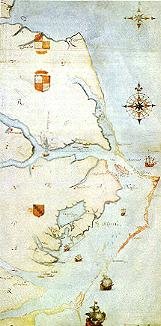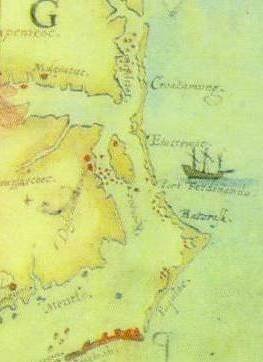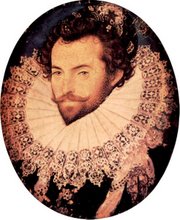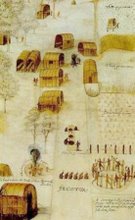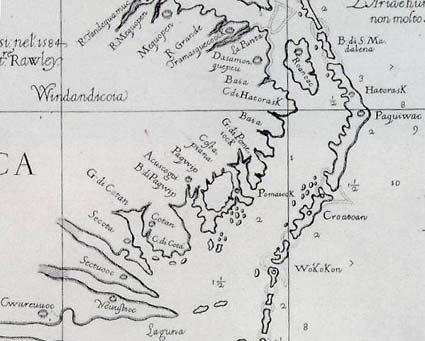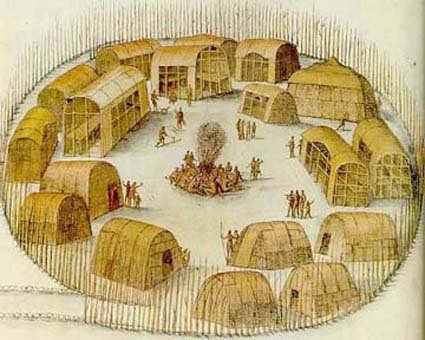Melungeon Myth of Drake Dropping off Passengers on Roanoke
By Janet Lewis Crain
A myth exists on the Internet that the Melungeons, a group of dark skinned
persons of mysterious origins found living in East Tennessee two hundred
years ago descend from Turkish prisoners and sundry other non-English persons
said to have been rescued by Sir Francis Drake during the sacking of Cartagena and
then deserted on Roanoke Island in 1586. In truth, there is NO evidence there
were any left behind there, much less several hundred. This myth was introduced
in a book published in the 1990's by Brent Kennedy titled The Melungeons:
The Resurrection of a Proud People : An Untold Story of Ethnic Cleansing in
America.
This book might have lanquished in obscurity on the shelves of a few Libraries
and book stores had it not been for the Internet and the new found surge
of interest in genealogy. Suddenly everyone fancied him or herself a Melungeon.
Several Unions were held of people from various mailing lists and persons attending
were happily discovering knots.on the back of their head, thought to indicate
Turkish ancestry. Having someone in your Family tree who possessed six
fingers was a definite plus. These traits were all described in the afore mentioned book.
No one ever looked too closely into the incident said to have occurred in 1586. But
that is precisely what this paper intends to do.
In the sixteenth century, Sir Francis Drake was one of the most famous men in England, indeed the English speaking world and beyond. He could do no wrong in his Queen's eyes. He had brought her an enormous return on her personal investment in an earlier voyage. A brilliant man in many ways, Drake was ruthless, but highly admired by the captives he had freed and the Maroons who came to his aid to help him fight and share in the rewards.
Drake was returning home from the sacking of Cartagena when he decided to
visit Roanoke and dispose of some of the freed prisoners and Maroons he had
acquired during his adventures. He was carrying a human cargo of some several hundred. Ivor Noel Hume in "Virginia Adventures" contends Drake
highly inflated the numbers. The voyage had not been financially successful
in spite of his daring and flamboyant actions. It is quite likely he was
advancing his case by sending back reports of greater exploits than actually
had occurred. There were reports of many nationalities released from the
Spanish prisons as well as Maroons who had come in from their strongholds in
the surrounding areas to help Drake as he was known to be generous with the
spoils of his marauding. Alas this voyage would not compare to previous ones.
This voyage is of great interest to Melungeon researchers because this
voyage in 1586 is the basis of the Turkish connection first started by
statements in Brent Kennedy's book: Melungeons; an Untold Story of Ethnic
Cleansing. It is, in fact, the keystone of the Turkish Connection Theory.
Remove it and the rest crumbles. That is what I propose to do.
It is known that many of the people with him never reached Roanoke. Many died of
strange fevers in Florida. These fevers were the scourge of sea travel at
that time. Caused in part by the crowding together of humans in the cargo
holds of ships where the fetid air trapped and spread any contagious
disease like wildfire, and probably acerbated by nutritional deficiencies.
In any case, reports contend that anywhere between 350 and 750 people died of
these fevers. Apparently Drake intended to leave the rest of the freed
Africans and South American Indians to furnish labor for the new Colony on
Roanoke which he expected to have grown to some 600 English by then. In
truth There were only about 100 men, badly in need of food and suffering the
ill effects of their bad treatment of the local Indians. Ralph Lane was in
charge at Roanoke and he accepted Drake's offer of minimal food supplies
(Drake had been out a long time and was running low himself) and a ship, the
Francis, capable of navigation into the bay plus other pinnaces, etc. and
armament. All the supplies were loaded onto the Francis along with Lane's
best naval officers. Lane wanted to stay a few more weeks exploring the
Chesapeake.
Hume states:
When on June 11, the two men (Francis Drake and Ralph Lane) exchanged their
unsettling news, several truths became evident; Drake was not there (as the
Roanoke settlers had first hoped) to resupply the Colony; he was short of
food himself and so was better able to supply guns than butter. Futhermore,
Lane could not have had any desire or ability to house 250 blacks who would
out number his white settlers two to one.
They came to an agreement whereby Drake would leave skilled workers,
artisans, two pinnaces, several small boats and a large ship, the Francis.
All the supplies were loaded onto the Francis along with the skilled
mariners needed to sail such a ship. Immediately a terrible hurricano struck
and it was every man for himself. The ships standing out in the roadway cut
and ran, scurrying out to the deep ocean to get away from the treacherous
shoals and currents, dangerous enough in good weather. The Francis was among
those who sailed on to England.
Ralph Lane then accepted Drake's offer to transport the first colonists back
To England. Most of the small pinnaces carrying the extra passengers had
been dashed to pieces on the shoals during the storms. The Turks, known to
have been with Drake, were apparently better safeguarded. They were valuable
as trade for English prisoners lanquishing in Ottoman prisons. Some 100
Turks were, in fact, ransomed to their homeland.
So, just who might have gone ashore before the storm hit? Many people have a
hard time visualizing the scene at Roanoke. Roanoke is surrounded by very
shallow waters, hence the name; Shallowbag Bay. The only way to get there
was by laborious offloading of men and supplies to shore boats and threading
through the one pass, Fernando Pass, and the treacherous shoals and currents
made worse at times by Northwestern winds blowing directly into the Bay. The
shore boats were large by our standards and equipped with a mast and sail.
They require a skilled pilot and several strong sailors to row. People didn't
just hop on one and go sight seeing. Only those with important business
such as Sir Francis Drake and Ralph Lane who negotiated several times were
transported back and forth. The rest of the fleet with the passengers
onboard stood out in the Roadway, the navigable waters off the Outer Banks,
which wrap around this area like protecting arms.
I am saying this to lay to rest the idea of a huge number of the passengers
dis-embarking and perhaps being caught off guard by the storms and staying
behind. Hume and David Beers Quinn are the authorities on this period and
both say there were no Turks left. Hume says no one else, Quinn, at most a
very few. Left with no supplies on the Outer Banks what would they have
found to eat? If the Indians had not killed them, they would have starved.
It should be noted that the Native Americans communicated by a"grapevine" so
efficient that Indians in Canada knew of happenings in the Virginias. No
mention of any dumped off passengers was ever made.
Additionally, there was plenty of room for these passengers to sail with
Drake. Hundreds had died in the battles in Florida, from fevers, and in the
hurricane. Drake was returning with more ships than he left with, having
captured many. And they would have furnished badly needed labor to sail
these ships back to England.
Add to this the extreme difficulty of unloading these passengers in addition
to loading the Roanoke settlers, which the crew deeply resented for the
delay and extra work and danger this imposed and it is highly unlikely Drake
would have taken such actions in the middle of a three day hurricane.
Ivor Noel Hume says:
Thus the hurricane of June 1586 may have ripped away the first page from the
history of blacks in English America.
A cruel and terrible fate for these forgotten people that historians of the
time did not consider important enough to even record their fate.
Two weeks later an emergency supply ship sent by Sir Richard Grenville
arrived and found no one although they searched diligently. They left to return to England.
About one or two weeks later a big supply ship arrived with Grenville on
board. They were as mystified at the deserted condition of the island as the
men on the earlier supply ship. They searched even further "into the main"
(mainland) and as far as Chesapeake. Grenville was heavily invested in this
first effort, having sold an entire estate (consisting at this time as a
manor house and every type of supporting industry needed to run the estate;
mills, stables, barns, houses, dairies, animals, tools, even small villages)
to finance the settlement of over 100 men for over a year. It was a
requirement of Raleigh's patent from Queen Elizabeth that the area be
occupied continuously by English people. Finding no one and not knowing where
they had gone, he left some 15 soldiers to hold the fort. Based upon later
interviews with Indians, they all perished.
It is quite clear they found no one who could have been the passengers Drake
was previously carrying.
As previously stated the Indians had a very effective rumor mill which
carried news far and wide. It is just inconceivable that these
people could have survived unnoticed when their appearance would have been a
matter of great curiosity among people who had never seen African natives.
Thus it seems there is no evidence that any people were left behind in the Colony and documented evidence that 100 turks were returned to their homeland.
Resources:
The Virginia Adventurers by Ivor Noel Hume Copyright 1994 p. 53
Corbett, Spanish War. Refers to the return of 100 ex-galley slaves to the
Turkish dominions.
William S. Powell, North Carolina through Four Centuries, p. 42. Refers to
Queen Elizabeth's reason for returning the Turks.
David Beers Quinn, Roanoke Voyages. Cites Wright in footnote regarding Turks
Wright, Further English Voyages. Source of Quinn's information about Turks.
Hakluyt Society for 1975, Second Series, No. 148, p. 202, Note 3. Sir
Francis Drake's West Indian Voyage, 1585-1586. A detailed and authorative
account.
Acts of the Privey Council, 1586-87, PP. 205-206. (Public Record Office
[London]), PC 2/14:169) Contains a letter from the Queen's Privey Council
addressed to a merchant in London, who traded with Turkey, that asks him to
make arrangements for the return of 200 Turks to Turkey.
Document 10, The Primrose Journal (British Library Royal MS.7C,xvi, folders
166-173. Capt. Frobisher's journal of the 1586 Drake-led voyage. Mentions
Turks being aboard his ship.
David Beers Quinn Set Fair for Roanoke
David Beers Quinn The Roanoke Voyages 1584-1590
This blog is © History Chasers
Click here to view all recent Lost Colony Research Group Blog posts
Tuesday, April 17, 2012
Posted by
Historical Melungeons
at
4/17/2012 12:49:00 AM
![]()
Labels: drake, first colony, hatteras, lane, Melungeon, outer banks, Raleigh, roanoke, turks
Monday, November 5, 2007
Descendants of the 'Lost Colonists' Forced to Flee Their Own Homes
Cartuca was the capital of the people whose ancestors were known to Raleigh's colonists as Croatans. That the people of King Tom Taylor of Cartuca were descended from members of the Lost Colony may be concluded from the Congressional Report of 1914-1915, by Special Indian Agent O.M. McPherson. It precluded their classification as "Native Americans," with the benefits they would derive from this status. Hugh and Clement Taylor were both members of the Lost colony, but it is not known which, if either, was an ancestor of King Taylor.
When John Lawson and Baron De Graffenried conspired and contracted for the settlement of Palatines in the geographically strategic site of Cartuca--now New Bern--in 1710, the people of King Taylor were pleased at the prospect of European neighbors. Their king was maternally descended from Sir Manteo (knighted Lord of Roanoake and Dasamonguepeuk by Queen Elizabeth) and an english adventurer named Taylor, and they were pleased at the prospect of European neighbors.
The Palatines, from the border electorate of European kings, between France and Germany, had other plans, however. They had no intentions of allowing the Indians to remain in the area of the junction of the Trent and Neuse Rivers. The site controlled heavy freight traffic to the land's interior. With a few well-placed cannons De Graffenried could control shipping there as surely as his ancestors (cousins to the English royalty) controlled the junction of the Neckar and the Rhine.
The sale of Cartuca (Core Tucka, the new Currituck)was a momentous event for the Indians. They saw it as the beginning of a new way of life for them. What sort of a new way of life was soon to become clear to them as the mysterious Corees, who became extinct.
On the night of the celebration of the sale of Cartuca to the whites, it became clear to King Taylor that John Lawson had bargained away far more than Taylor ever intended to sell. His first awareness of the real extent of his peoples' loss brought from him an eloquent plea for brotherhood and cooperation between the whites and the Indians, in the English dialect of the Raleigh colonists.
The unaccustomed spectacle of a savage in European clothing, presenting an impassioned plea for unity with the Europeans, was more than one of the Palatines could take. Michel, a geologist and mining expert, raging drunk on raw rum, jumped on King Taylor and pummeled him mercilessly.
Such behavior on such an occasion was inconceivable to the Indians. To even interrupt a tribal chief was a capitol offense, at the chief's discretion. Michel's brutality ended the festivities for the natives of Cartuca. When Michel was pulled from the battered and bleeding Taylor, John Lawson delivered an ultimatum to the Indians. They must immediately leave Cartuca--and the surrounding area!
The shock to the Indians was profound. The loss to them was suddenly clear. Their home, with its wattled Welsh peasant style houses was no longer theirs. They were expected to vacate Cartuca immediately!
After his painful humiliation before the assembly of whites and his people, King Taylor raged in drunken indignation and disbelief in his own cabin. He rambled on about his white ancestry. He spoke of the nobility of his Indian ancestors, and the appreciation shown to them by the Virgin Queen. And he moaned his grief that John Lawson and the Palatines were such ungracious subjects of a sovereign who succeeded her.
As King Taylor rambled on, loudly and bitterly, English settlers and their friendly Tuscarora neighbors from the Albemarle, who had come to the celebration of New Bern's founding, continued to carouse around the big bonfire with the Palatines. Each outburst of rage and frustration from Taylor's house brought a roar of raucous laughter from the wild gang around the fire.
Loudly some wag in the crowd pointed out to Michel that his English was not nearly so fine as that of King Taylor! Another pointed out that the beating Michel gave him only served to sharpen Taylor's tongue! At this, Michel jumped up, kicked a shower of burning embers from the fire, and vowed to kick as many sparks from the Indian leader's arsch!
Michel ran to Taylor's house, followed by the drunken mob that roared its approval, and kicked open the door. King Taylor was astonished to find his privacy so violated. As he rose to protest, the enraged German pounced on him. Michel again pummeled Taylor mercilessly, knocking him down. When the Indian chief struggled to rise, Michel slammed a boot to his body that kicked him out the door. That was the way King Taylor left his home in Cartuca.
The Indian leader sprawled unconscious in the dirt, as Michel ordered the other Indians from their home. The women of the Taylor household were allowed to hastily gather a few belongings, as the young Indian men picked up their battered father and erstwhile spokesman, of whom they had always been so proud. Then they vanished into the darkness, the way Indians always do.
This was really the opening battle of the Tuscarora War, of which John Lawson was the first officially documented victim. This was the opening battle of the war that pitted the Iroquoian Tuscaroras of Roquis Pocosin, who allied themselves with their English neighbors, against a hodge-podge of Sioux, Algonquins and renegade Iroquois (mostly Tuscaroras)--who saw their destinies prefigured in the disgraceful beating Taylor took. King Taylor--who had so prided himself on his English ancestry.....
Full Article Here:
http://www.dickshovel.com/coreewho.html
Posted by
Historical Melungeons
at
11/05/2007 04:23:00 PM
![]()
Labels: colonies, crotoans, drake, England, indians, john lawson, Lumbee, manteo, Philip Amadas
Tuesday, September 25, 2007
If you lost this cannon, please call scientists
A find at sea from 24 years ago begs the question of about how it came to rest on the ocean floor.
Courtesy of Roanoke Island Festival Park, September 19, 2007
This cannon on display at Roanoke Island Festival Park in North Carolina
was found off the Virginia coast in 1983 by scallop fishermen.
Researchers dated it to the 1580s.
BY PATRICK LYNCH 247-4534
September 23, 2007
A small cannon dredged up by scallop fishermen off the Virginia coast 24 years ago is getting a second look as a possible mark of a shipwreck with a - potentially - very interesting history.Some historians believe it is an English cannon from the 1580s, and if the dating is correct it would be one of the oldest English artifacts ever found in the Americas.Its mere existence begs larger questions: How did it get to the bottom of the ocean? Did it merely go overboard or did a shipwreck leave it there? Whose ship was it? When did it happen?
Full Article Here:http://www.dailypress.com/news/dp-21163sy0sep23,0,4284916,full.story
Posted by
Historical Melungeons
at
9/25/2007 06:59:00 PM
![]()
Labels: 16th century, artifact, cannon, colonies, drake, England, john white, lost colony, roanoke, walter raleigh


